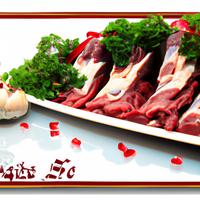
1 serving (100 grams) contains 294 calories, 25.0 grams of protein, 23.0 grams of fat, and 0.0 grams of carbohydrates.

Log this food in SnapCalorie

Nutrition Information
Calories |
700 | ||
|---|---|---|---|
% Daily Value* |
|||
| Total Fat | 54.8 g | 70% | |
| Saturated Fat | 23.1 g | 115% | |
| Polyunsaturated Fat | 0 g | ||
| Cholesterol | 231.0 mg | 77% | |
| Sodium | 171.4 mg | 7% | |
| Total Carbohydrates | 0 g | 0% | |
| Dietary Fiber | 0 g | 0% | |
| Sugars | 0 g | ||
| protein | 59.5 g | 119% | |
| Vitamin D | 0 mcg | 0% | |
| Calcium | 42.9 mg | 3% | |
| Iron | 4.9 mg | 27% | |
| Potassium | 738.1 mg | 15% | |
* Percent Daily Values are based on a 2,000 calorie diet. Your daily values may be higher or lower depending on your calorie needs.
Food Attributes
Source of Calories
About Raw lamb slices
Raw lamb slices, a versatile ingredient in global cuisine, are typically derived from cuts such as the leg, shoulder, or loin. Commonly featured in Middle Eastern, Mediterranean, and Central Asian dishes, lamb is prized for its rich, savory flavor. These slices are an excellent source of high-quality protein, essential for muscle growth and repair, and are rich in essential nutrients like iron, zinc, and vitamin B12, which support immune health and red blood cell production. Lamb also contains healthy fats, including omega-3 fatty acids, though it may be higher in saturated fat compared to other meats. Consumption should be moderated, especially for individuals monitoring their cholesterol. As raw lamb requires careful handling to avoid foodborne illnesses, it’s critical to source from trusted purveyors and prepare under safe conditions. Its nutrient density makes it a valuable option in balanced diets when enjoyed responsibly.



